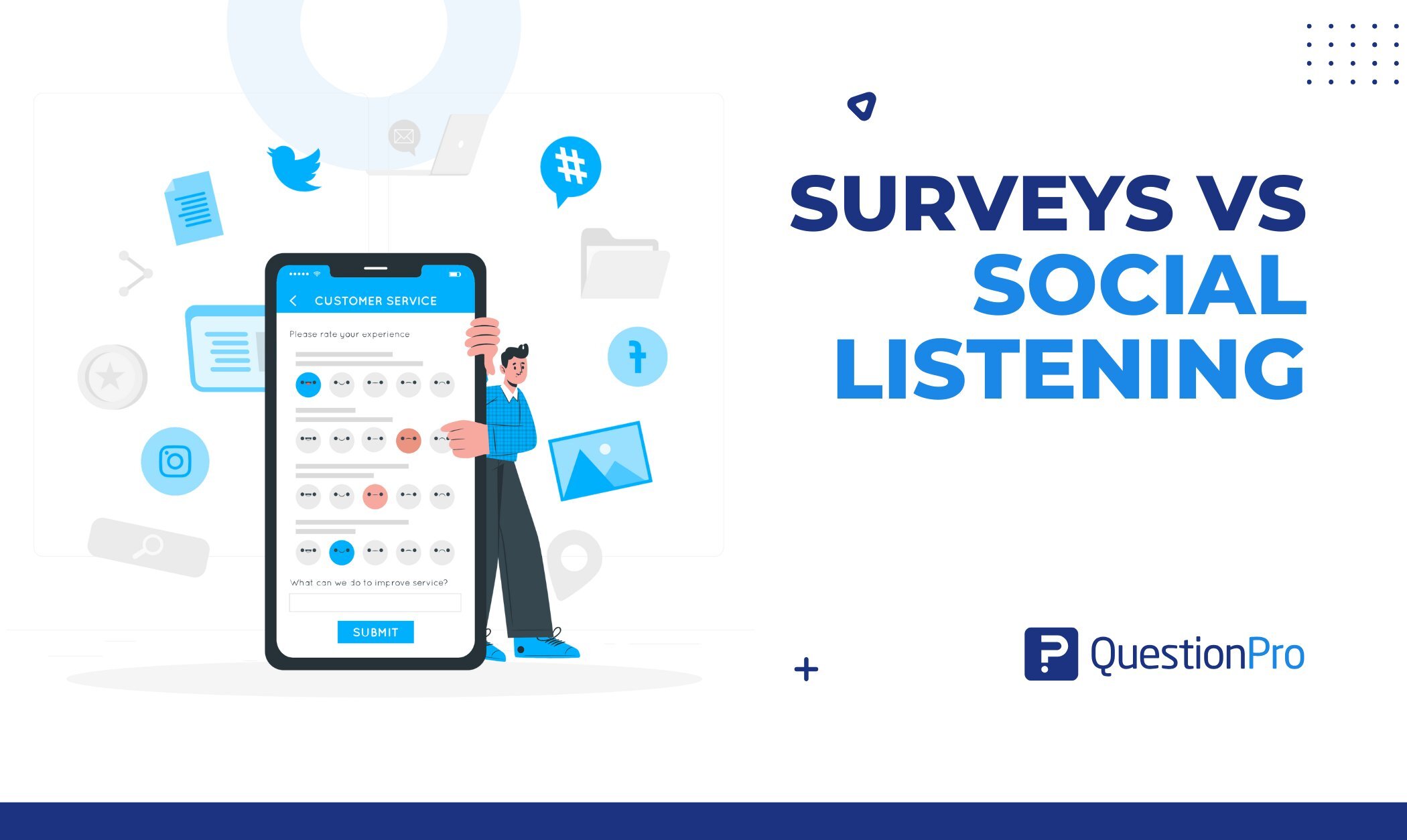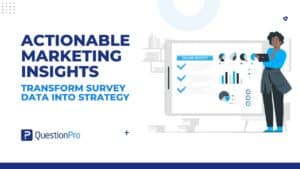
Marketers have more ways than ever to understand their audience. However, when they want to truly understand customer behavior, the question often arises about surveys vs. social listening and which one to choose.
Surveys offer structured, direct feedback from customers, and social listening captures unsolicited feedback from online conversations across social media and review platforms. Understanding the strengths and limitations of each approach is crucial for making informed marketing decisions.
In this post, we will explore how surveys vs. social listening compare, where each method excels, and how combining them can give marketers a complete view of their audience for smarter, data-driven strategies.
Understanding Surveys for Customer Feedback
Surveys are one of the most common tools for collecting structured data directly from customers. It is designed to capture specific insights about preferences, satisfaction, and behaviors.
Surveys are widely used across industries because they provide actionable information that can guide product development, marketing strategies, and customer experience improvements. A customer feedback survey lets you systematically understand your audience. It is particularly useful for measuring opinions on products, services, or experiences in a way that can be quantified and analyzed.
One of the key benefits of surveys is that they provide direct feedback from your audience. You can ask targeted questions and receive responses directly from customers. By carefully crafting questions and targeting the right audience, you can gather both quantitative and qualitative insights that can help with smarter decision-making.
Surveys also have limitations, such as low response rates, which may affect the reliability of the data collected. Answers can sometimes be biased due to question framing, participant self-selection, or a desire to provide socially acceptable responses.
Learn More: What are surveys, their characteristics, and examples
Understanding Social Listening Insights
Social listening takes a completely different approach. Instead of asking, you’re observing what people are already saying online. This includes:
- Social media platforms like X (Twitter), Instagram, or TikTok
- Forums and online communities
- Review sites and blogs where people share unfiltered opinions
With the right tools, marketers can analyze social media conversations, spot social listening insights, and track real-time customer sentiment without ever sending a survey. It is particularly valuable for identifying emerging trends, tracking brand reputation, and uncovering issues or opportunities that customers may not directly share through surveys.
Social listening data can be unstructured and noisy. It often contains slang, sarcasm, or irrelevant mentions, which require careful analysis to extract meaningful insights. It is also harder to target specific audience segments, and generally requires advanced tools and analysis.
In Case You Missed It: What is social listening and how to do it right
Surveys vs. Social Listening: The Core Difference
When you compare surveys vs. social listening side by side, you can see how different they are in structure, speed, and the type of insights they provide. Here’s a quick comparison to make it easier for you to spot the differences:
| Feature | Surveys (Structured Feedback) | Social Listening (Unsolicited Feedback) |
| Data Source | Responses to your predefined questions | Conversations happen naturally online |
| Control Over Questions | Full control, you design the questions and the audience | No control, people talk about what they want |
| Type of Feedback | Structured, easy to organize, and analyze | Unstructured, raw, and often emotional |
| Speed of Insights | The slower you need to design, launch, and collect responses | In real-time, you see opinions as they happen |
| Depth of Data | Focused on specific topics you choose | Broader, covers topics you may not have anticipated |
| Best Use Case | Measuring satisfaction, testing ideas, and collecting benchmarks | Tracking sentiment, spotting trends, and understanding conversations |
| Data Quality | Consistent but may suffer from survey fatigue or bias | Authentic but can be noisy or require cleaning |
Surveys vs. Social Listening: Which Gives Better Insights?
When it comes to understanding customer behavior, both surveys and social listening offer unique advantages, but they excel in different ways. Choosing the right method depends on the type of insights marketers need and the context in which the feedback will be used.
Surveys are especially useful when you want answers to specific questions, such as:
- Customer satisfaction with a new product
- Preferences for specific features or services
- Feedback on marketing campaigns or messaging
For example, A software company can run a survey asking users to rate the usability of a new feature. The results will give clear, actionable data that can guide product improvements.
Social listening provides insights that surveys might miss. It is useful in:
- Monitoring brand reputation in real time
- Detecting trends before they become widespread
- Understanding emotional tone and context behind opinions
A retail brand can track social media conversations and complaints about shipping delays. This insight can help them to address the issue quickly, even if customers haven’t filled out a survey.
While each method has its strengths, combining them provides the most comprehensive view of your audience.
- Use surveys when you need precise, structured feedback.
- Use social listening for trend spotting, sentiment analysis, and real-time monitoring.
- Combine both methods to balance quantitative accuracy with qualitative depth.
How Marketers Can Use QuestionPro for Surveys and Social Listening
QuestionPro is a powerful platform that helps marketers capture both structured and unstructured customer insights in one place. By combining survey capabilities with social listening features, QuestionPro enables teams to gather, analyze, and act on feedback more efficiently.
Marketers can take advantage of QuestionPro’s tools to streamline research and get actionable insights. Some of the key features that make it effective include:
- Create and distribute surveys easily
QuestionPro allows marketers to design surveys with customizable templates, logic branching, and multi-channel distribution, which ensures high-quality responses.
- Analyze survey data efficiently
Built-in analytics tools provide detailed reports, visualizations, and trend analysis, which can help marketers quickly identify actionable insights.
- Monitor social media and online feedback
QuestionPro’s social listening tools track mentions, sentiment, and conversations across social media, forums, and review sites.
- Integrate insights for holistic understanding
Combining survey responses with social listening data gives a complete picture of customer sentiment and behavior.
- Real-time alerts and trend tracking
Marketers can detect emerging issues or opportunities as they happen, enabling proactive decision-making.
Using QuestionPro not only simplifies the process of gathering feedback but also helps teams effectively leverage the data.
Conclusion
Choosing between surveys vs. social listening doesn’t have to be an either-or decision. Both methods provide valuable insights, but they serve different purposes. Surveys offer structured, targeted feedback, and social listening captures real-time, unsolicited opinions.
For the most complete understanding of your audience, combining surveys and social listening is the ideal approach. Platforms like QuestionPro make this integration easier for marketers. With QuestionPro, you can create and distribute surveys to gather structured customer feedback, while also monitoring social media and online channels to capture unsolicited insights.
By using QuestionPro, marketers can make informed, data-driven decisions that improve products, campaigns, and overall customer experience. Whether focusing on structured survey responses, real-time social feedback, or a combination of both, QuestionPro lets brands understand their audience deeply, respond quickly to trends, and gain a competitive edge.
Frequently Asked Questions (FAQs)
Answer: Surveys collect structured, direct feedback from customers through targeted questions. On the other hand, social listening monitors unsolicited online conversations across social media, forums, and review sites to capture sentiment, trends, and opinions in real time.
Answer: Accuracy depends on your goals. Surveys are better for precise, quantitative data on specific topics, while social listening excels at capturing qualitative, real-time sentiment. Using both together provides the most complete understanding of your audience.
Answer: Marketers can run surveys to gather structured feedback while simultaneously monitoring online conversations through social listening. Integrating these insights creates a complete view of customer sentiment, highlights gaps, and supports data-driven decision-making.
Answer: Surveys are typically conducted periodically, and social listening should be an ongoing process.
Answer: Yes. QuestionPro allows marketers to create and distribute surveys while tracking social media and online channels for real-time feedback. It integrates survey results with social listening insights, helping teams make informed marketing decisions efficiently.







